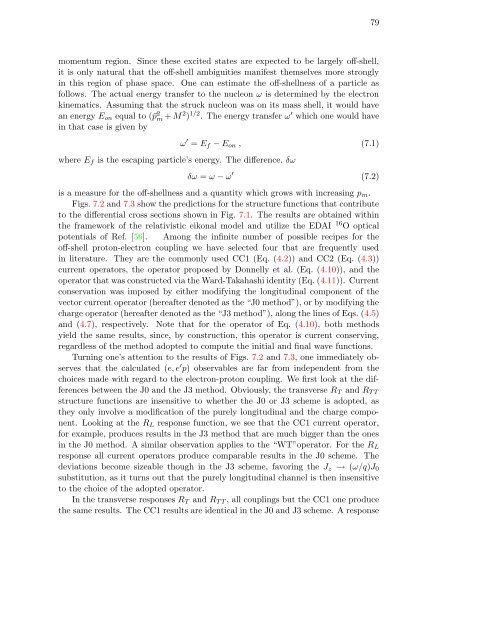Download Thesis in Pdf Format - Theoretical Nuclear Physics and ...
Download Thesis in Pdf Format - Theoretical Nuclear Physics and ...
Download Thesis in Pdf Format - Theoretical Nuclear Physics and ...
Create successful ePaper yourself
Turn your PDF publications into a flip-book with our unique Google optimized e-Paper software.
79<br />
momentum region. S<strong>in</strong>ce these excited states are expected to be largely off-shell,<br />
it is only natural that the off-shell ambiguities manifest themselves more strongly<br />
<strong>in</strong> this region of phase space. One can estimate the off-shellness of a particle as<br />
follows. The actual energy transfer to the nucleon ω is determ<strong>in</strong>ed by the electron<br />
k<strong>in</strong>ematics. Assum<strong>in</strong>g that the struck nucleon was on its mass shell, it would have<br />
an energy E on equal to (⃗p 2 m + M 2 ) 1/2 . The energy transfer ω ′ which one would have<br />
<strong>in</strong> that case is given by<br />
ω ′ = E f − E on , (7.1)<br />
where E f is the escap<strong>in</strong>g particle’s energy. The difference, δω<br />
δω = ω − ω ′ (7.2)<br />
is a measure for the off-shellness <strong>and</strong> a quantity which grows with <strong>in</strong>creas<strong>in</strong>g p m .<br />
Figs. 7.2 <strong>and</strong> 7.3 show the predictions for the structure functions that contribute<br />
to the differential cross sections shown <strong>in</strong> Fig. 7.1. The results are obta<strong>in</strong>ed with<strong>in</strong><br />
the framework of the relativistic eikonal model <strong>and</strong> utilize the EDAI 16 O optical<br />
potentials of Ref. [56]. Among the <strong>in</strong>f<strong>in</strong>ite number of possible recipes for the<br />
off-shell proton-electron coupl<strong>in</strong>g we have selected four that are frequently used<br />
<strong>in</strong> literature. They are the commonly used CC1 (Eq. (4.2)) <strong>and</strong> CC2 (Eq. (4.3))<br />
current operators, the operator proposed by Donnelly et al. (Eq. (4.10)), <strong>and</strong> the<br />
operator that was constructed via the Ward-Takahashi identity (Eq. (4.11)). Current<br />
conservation was imposed by either modify<strong>in</strong>g the longitud<strong>in</strong>al component of the<br />
vector current operator (hereafter denoted as the “J0 method”), or by modify<strong>in</strong>g the<br />
charge operator (hereafter denoted as the “J3 method”), along the l<strong>in</strong>es of Eqs. (4.5)<br />
<strong>and</strong> (4.7), respectively. Note that for the operator of Eq. (4.10), both methods<br />
yield the same results, s<strong>in</strong>ce, by construction, this operator is current conserv<strong>in</strong>g,<br />
regardless of the method adopted to compute the <strong>in</strong>itial <strong>and</strong> f<strong>in</strong>al wave functions.<br />
Turn<strong>in</strong>g one’s attention to the results of Figs. 7.2 <strong>and</strong> 7.3, one immediately observes<br />
that the calculated (e, e ′ p) observables are far from <strong>in</strong>dependent from the<br />
choices made with regard to the electron-proton coupl<strong>in</strong>g. We first look at the differences<br />
between the J0 <strong>and</strong> the J3 method. Obviously, the transverse R T <strong>and</strong> R T T<br />
structure functions are <strong>in</strong>sensitive to whether the J0 or J3 scheme is adopted, as<br />
they only <strong>in</strong>volve a modification of the purely longitud<strong>in</strong>al <strong>and</strong> the charge component.<br />
Look<strong>in</strong>g at the R L response function, we see that the CC1 current operator,<br />
for example, produces results <strong>in</strong> the J3 method that are much bigger than the ones<br />
<strong>in</strong> the J0 method. A similar observation applies to the “WT”operator. For the R L<br />
response all current operators produce comparable results <strong>in</strong> the J0 scheme. The<br />
deviations become sizeable though <strong>in</strong> the J3 scheme, favor<strong>in</strong>g the J z → (ω/q)J 0<br />
substitution, as it turns out that the purely longitud<strong>in</strong>al channel is then <strong>in</strong>sensitive<br />
to the choice of the adopted operator.<br />
In the transverse responses R T <strong>and</strong> R T T , all coupl<strong>in</strong>gs but the CC1 one produce<br />
the same results. The CC1 results are identical <strong>in</strong> the J0 <strong>and</strong> J3 scheme. A response















